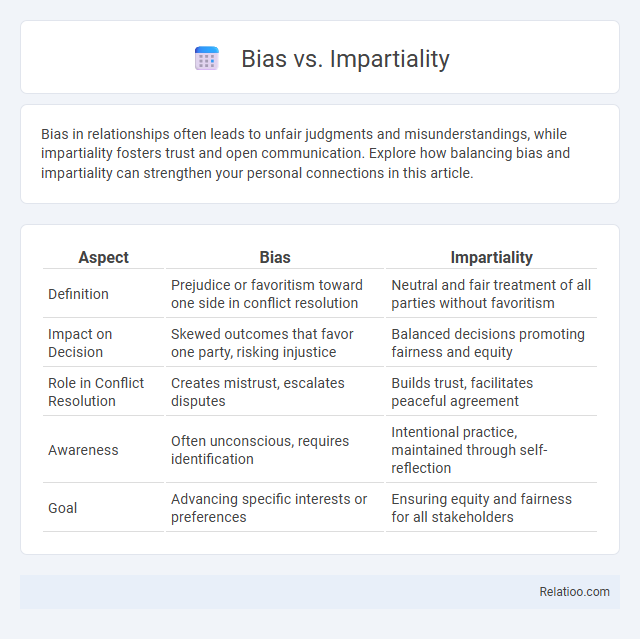Bias in relationships often leads to unfair judgments and misunderstandings, while impartiality fosters trust and open communication. Explore how balancing bias and impartiality can strengthen your personal connections in this article.
Table of Comparison
| Aspect | Bias | Impartiality |
|---|---|---|
| Definition | Prejudice or favoritism toward one side in conflict resolution | Neutral and fair treatment of all parties without favoritism |
| Impact on Decision | Skewed outcomes that favor one party, risking injustice | Balanced decisions promoting fairness and equity |
| Role in Conflict Resolution | Creates mistrust, escalates disputes | Builds trust, facilitates peaceful agreement |
| Awareness | Often unconscious, requires identification | Intentional practice, maintained through self-reflection |
| Goal | Advancing specific interests or preferences | Ensuring equity and fairness for all stakeholders |
Understanding Bias: Definitions and Origins
Bias refers to a predisposition or prejudice toward a particular perspective, often rooted in cognitive, cultural, or societal influences that shape individual or group judgments. Impartiality involves the deliberate effort to remain neutral and refrain from favoritism, ensuring fairness in evaluation or decision-making processes. Objectivity requires approaching information and situations based on observable facts and evidence, minimizing personal feelings or biases to achieve an accurate and balanced understanding.
Impartiality Explained: What Does It Mean?
Impartiality means treating all parties fairly without favoritism or prejudice, ensuring decisions are based on facts and evidence rather than personal feelings or biases. It requires maintaining neutrality and avoiding conflicts of interest to uphold trust and credibility in any judgment or evaluation. Your commitment to impartiality guarantees that outcomes are fair, balanced, and respected by everyone involved.
Types of Bias in Information and Decision-Making
Types of bias in information and decision-making include confirmation bias, where you favor data confirming preexisting beliefs, and anchoring bias, which causes overreliance on initial information. Selection bias occurs when data samples are not representative, skewing results, while cognitive bias affects judgment through subconscious mental shortcuts. Understanding these biases helps ensure impartiality by promoting objective, balanced evaluation of evidence and options.
The Importance of Impartiality in Journalism
Impartiality in journalism ensures that reporting remains fair and balanced, presenting facts without favoritism or prejudice. Your trust in news sources depends on their ability to avoid bias, enabling you to make informed decisions based on accurate, objective information. Upholding impartiality strengthens the credibility of the media and promotes a well-informed society.
Cognitive Biases and Their Impact
Cognitive biases, such as confirmation bias and anchoring, significantly distort your decision-making by filtering information through subjective lenses, undermining both impartiality and objectivity. Impartiality requires fairness and neutrality, whereas objectivity demands evidence-based reasoning free from emotional influence or preconceived notions. Understanding these biases enhances your ability to recognize and mitigate their impact, fostering clearer, more rational judgments.
Strategies to Identify Personal and Institutional Bias
Strategies to identify personal and institutional bias include conducting regular self-assessments and implicit bias training to uncover unconscious prejudices affecting decision-making processes. Organizations can implement standardized evaluation criteria and use diverse review panels to minimize subjective influence and promote fairness. Leveraging data analytics tools helps detect systemic patterns of bias, ensuring policies and practices align with principles of impartiality and objectivity.
Tools and Techniques to Foster Impartiality
Tools such as blind recruitment software, structured interviews, and algorithmic decision-making platforms help reduce bias by standardizing evaluation criteria and minimizing subjective influence. Techniques like training programs on unconscious bias, diverse panel assessments, and continuous feedback loops foster impartiality by promoting awareness and accountability. Implementing data analytics to monitor decision patterns also supports objectivity by identifying inconsistencies and ensuring evidence-based, fair outcomes.
Ethical Implications of Bias vs Impartiality
Bias distorts information processing by coloring judgments with personal or systemic preferences, undermining fairness and ethical standards in decision-making. Impartiality demands the exclusion of favoritism, ensuring equitable treatment and upholding trust in professional and social environments. Your commitment to impartiality enhances ethical integrity by fostering transparency and accountability, crucial for just outcomes and moral responsibility.
Case Studies: Bias and Impartiality in Real Life
Case studies revealing bias and impartiality in real life highlight how personal prejudices can distort decision-making, impacting outcomes in legal trials, media reporting, and hiring processes. For example, examining wrongful conviction cases exposes how implicit bias influences jurors and law enforcement, while objective frameworks help mitigate these effects by promoting evidence-based judgments. Studies in journalism demonstrate that impartial reporting improves public trust, contrasting with biased coverage that often leads to misinformation and societal polarization.
Building a Culture of Impartiality
Building a culture of impartiality requires fostering an environment where decisions and evaluations are made based on objective criteria, free from personal biases or prejudices. Organizations can implement structured training programs to increase awareness of cognitive biases and establish standardized protocols that ensure consistent, evidence-based assessments. Promoting transparency and accountability further reinforces impartial practices, enhancing trust and fairness across all levels of the organization.

Infographic: Bias vs Impartiality
 relatioo.com
relatioo.com